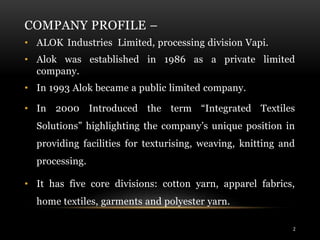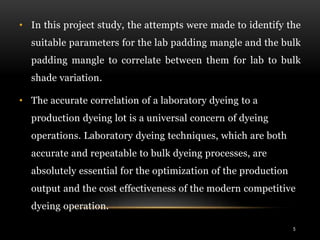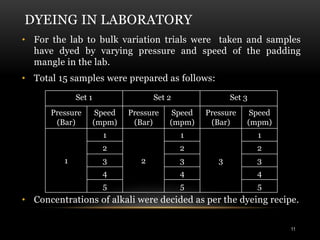Project presentation
- 1. JAYWANT JAGDISH BARI SWARANJALI SUHAS JOSHI D.T.T. – IV Year A STUDY PROJECT ON LAB TO BULK SHADE VARIATION FOR PAD BATCH DYEING A PROJECT WORK DONE AT ALOK INDUSTRIES LTD. 1
- 2. COMPANY PROFILE – • ALOK Industries Limited, processing division Vapi. • Alok was established in 1986 as a private limited company. • In 1993 Alok became a public limited company. • In 2000 Introduced the term “Integrated Textiles Solutions” highlighting the company’s unique position in providing facilities for texturising, weaving, knitting and processing. • It has five core divisions: cotton yarn, apparel fabrics, home textiles, garments and polyester yarn. 2
- 3. • Exports of 9 crore in FY 2000 and 2217 crore in FY 2011. • 1st textile company to get the IMS certification for its manufacturing facilities at Silvasa and Vapi. • Won the Ramakrishna Bajaj National Quality (RBNQ) performance trophy in 2010. • In 2001 Alok was 1st to invest under TUFS. • Opens home textiles sector in 2002. • Alok’s range in this segment includes - entire range of top of the bed i.e., sheets sets, duvets, comforters, blankets, quilts, jacquards, dobbies, prints, embroidery, yarn dyed. • Curtains and towels to its portfolio. 3
- 4. INTRODUCTION • The manufacturing of a textile begins with the fibre input, whereby each processing step results in an added cost to the final product. As dyeing of a textile is often the last step in the manufacturing of a fabric, it requires extra caution to get it right by avoiding waste and maintaining cost control. • There was a problem of shade variation of dyed fabrics in a textile company leading to the increase in process cycle time due to the extra amount of colour addition or stripping 4
- 5. • In this project study, the attempts were made to identify the suitable parameters for the lab padding mangle and the bulk padding mangle to correlate between them for lab to bulk shade variation. • The accurate correlation of a laboratory dyeing to a production dyeing lot is a universal concern of dyeing operations. Laboratory dyeing techniques, which are both accurate and repeatable to bulk dyeing processes, are absolutely essential for the optimization of the production output and the cost effectiveness of the modern competitive dyeing operation. 5
- 6. COLD PAD BATCH DYEING – • Fabric is padded with a reactive dye in the presence of an alkali at cold temperature. • After padding the batches are wrapped in polyethylene sheet to prevent water evaporation and stored at room temperature. • Batching time is 12 to 16 hours in wet stage. • During the storage period, the rolls must be kept slowly rotating to prevent seepage of dye liquor. Because the alkaline liquor should collect at the lower portions of the batch due to gravity that could result in intermittent variation in shade along the length of the fabric. • The dyed fabric finally washed out. 6
- 7. 7 Cold Pad Batch Machine
- 8. FABRIC PREPARATION PRIOR TO DYEING • The fabric should be desized, bleached and mercerized. • The essential requirements are - Material must be made available for dyeing in neutral form. - Uniform and readily absorbent. - Residual size content should be nil. - Whiteness of the fabric should be even. • Such pretreatments give the further advantage of better colour yield. 8
- 9. • Parameters checked for chemicals - Alkali concentrations by titration method - Alkali solution pH - Dye solution pH - Pad liquor pH • Machine parameters - Trough temperature - Speed of the machine - Mangle pressure 9
- 10. DYEING ON BULK PADDING MACHINE • Concentration of chemicals Dyes – X gpl (as per the recipe) Soda ash (sodium carbonate) – 20 gpl Caustic soda (sodium hydroxide) – varies for light, medium and dark shades. • Trough temperature – below 25° C. • Mangle pressure – L : 1.8 bar, M : 1.1 bar, R : 1.8 bar. • Dwell in pad liquor – 3 to 4 sec. • Speed of the machine – 40 Mtr/ min. • Batching time – 12 to 16 hrs. 10
- 11. DYEING IN LABORATORY • For the lab to bulk variation trials were taken and samples have dyed by varying pressure and speed of the padding mangle in the lab. • Total 15 samples were prepared as follows: • Concentrations of alkali were decided as per the dyeing recipe. Set 1 Set 2 Set 3 Pressure (Bar) Speed (mpm) Pressure (Bar) Speed (mpm) Pressure (Bar) Speed (mpm) 1 1 2 1 3 1 2 2 2 3 3 3 4 4 4 5 5 5 11
- 12. • Then the samples were wrapped in polyurethane. • These wrapped samples had been kept in Rota dyer’s pot separately for rotation at 60° C for 30 min. • After 30 min. samples were taken for washing, first cold wash then soaping at 100° C and neutralizing with cold water. • Then the washed samples were dried. 12
- 13. COLOUR DIFFERENCE EVALUATION • The samples dyed in the bulk were collected after washing. • The samples dyed in the bulk had been compared with the samples dye in the laboratory. • Before the samples were checked for colour difference, they are kept for conditioning. • The difference in the shade of the samples were checked by using the Spectrophotometer. 13
- 14. SHADE – SAGE • Recipe – A • Novacron Yellow CRG – 0.9128 gpl. • Novacron Blue C5X – 0.8912 gpl. • Novacron Red HF4BC – 0.3632 gpl. • Acetic acid – 0.1 gpl. 14
- 15. Sr. no. Process ΔL ΔC ΔH ΔE Strength % Remarks 1 Bulk 0.07 - 0.13 - 0.36 0.39 99.57 Light, redder-blue Lab Pressure Speed 2 1 1 -1.34 1.15 0.47 1.83 135.60 Dark, greener-yellow 3 2 -0.98 0.98 0.24 1.41 125.19 Dark, greener-yellow 4 3 - 1.14 1.11 0.23 1.61 129.12 Dark, greener-yellow 5 4 -1.00 0.77 0.40 1.32 126.17 Dark, greener-yellow 6 5 -0.89 0.55 0.47 1.15 123.39 Dark, greener-yellow 7 2 1 -0.72 0.78 0.31 1.10 118.33 Dark, greener-yellow 8 2 -0.59 0.70 0.31 0.96 114.84 Dark, greener-yellow 9 3 -0.61 0.61 0.70 1.10 115.09 Dark, greener-yellow 10 4 -0.36 0.49 0.48 0.77 109.13 Dark, greener-yellow 11 5 -0.69 0.71 0.40 1.07 117.30 Dark, greener-yellow 12 3 1 -0.51 0.64 0.68 1.06 112.89 Dark, greener-yellow 13 2 -0.10 0.60 0.15 0.63 102.37 Dark, greener-yellow 14 3 -0.12 0.49 0.40 0.64 102.89 Dark, greener-yellow 15 4 -0.03 0.47 0.40 0.61 100.81 Dark, greener-yellow 16 5 -0.07 0.23 0.68 0.73 102.12 Dark, greener-yellow15
- 16. RESULTS AND DISCUSSION • CMC difference values of various samples dyed by pad batch method using recipe A for the shade Sage have shown in the table. • The approved sample was taken for the comparison. • The shade produced in bulk was little lighter than the approved sample. • From Table it was observed that for the pressures 1 and 2 bars, shade produced were considerable darker and greener-yellower in tone. • So in the next experiment pressure was increased to 3 bars and 5 samples were produced at various mangle speeds. The strength of all the samples was very close to standard i.e. 100-102 %. 16
- 17. • It was also noticed from Table that as mangle pressure increases, the strength of samples decreases. • This is due to the reduction of wet pick up or percentage expression at higher pressure. • Also, as the speed of machine increases, the strength of the samples decreases. This decrease in strength at higher speed may be due to lower wet pick up at higher speed. • The same results were also presented graphically. 17
- 18. 99.5 135.6 125.1 129.1 126.1 123.3 118.3 114.8 115 109.1 117.3 112.8 102.3 102.8 100.8 102.1 90 95 100 105 110 115 120 125 130 135 140 Strength% Dyed samples Shade - Sage Bulk P 1/ S 1 P 1/ S 2 P 1/ S 3 P 1/ S 4 P 1/ S 5 P 2/ S 1 P 2/ S 2 P 2/ S 3 P 2/ S 4 P 2/ S 5 P 3/ S 1 P 3/ S 2 P 3/ S 3 P 3/ S 4 P 3/ S 5 18
- 19. CONCLUSIONS • After taking the trials on 15 different shades we have concluded as follows: • The % strength of the shade dyed in the laboratory were considerably darker than the shade of bulk dyed samples. • While dyeing in the laboratory, pressure of 3 bar and higher speed up to 5 Mtr/min. would be best applicable condition on padding machine. 19


















